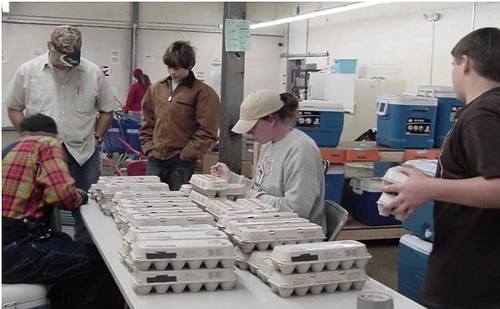
One afternoon in the fall of 2003, 36 consumers and several volunteers gathered in the basement of an Oklahoma City church to sort and purchase products from twenty local producers. They generated $3,500 in sales, and the opening day of the Oklahoma Food Coop (OFC) was determined to have been a great success.
Today, seven years later, OFC has over 3,000 members and processes up to 700 orders monthly. The participating producers – all two hundred of them – generate about $70,000 in monthly sales from 4,000 locally produced products. The organization manages storage space, a warehouse and owns several trucks. It has transformed from a small buying club to a formal food hub.
Bob Waldrop, a church music director in Oklahoma City, is the visionary behind the Oklahoma Food Coop. For years, Bob knew the demand for local food in Oklahoma was great, and that the product was out there. But, he also knew there were great challenges to matching supply and demand. Customers didn’t know how to purchase directly from local producers, and producers weren’t sure how to target their products to reach their customer base. One challenge was simply communication: how could a local producer identify and directly reach customers amongst Oklahoma’s 3.6 million residents? And, how could consumers access some of Oklahoma’s finest locally produced food if they didn’t live on or near a farm themselves?
But the biggest challenge was how to get products off the local farms, which were mostly smaller livestock ranches and produce operations with little distribution infrastructure, and into the hands of individual consumers spread across the state’s 68,000 square miles.
The answer turned out to be a member cooperative with an easy to use Internet ordering program, coupled with a choreographed distribution system involving trucks, drop off points, warehouse space and a throng of committed volunteers. Each month, producers post the products they have to sell on the Oklahoma Food Coop website for customers to peruse and order. Once orders are calculated, producers bring their merchandise to a central warehouse in Oklahoma City where it is sorted, prepared, and organized. OFC trucks then crisscross Oklahoma’s roads, distributing orders to nearly 50 drop off locations throughout the state.
The Coop strictly enforces a “made in Oklahoma” policy for all products. Three major principles govern its business operations: financial viability for the producers, sustainable growing practices that do not waste natural resources, and the economic benefits of the business should be distributed equitably to those involved in its operation.
On one hand it might seems like a simple system: local producers post what they have on-line, consumers order, and product magically arrives to market. But there is so much more to it than that. As OFC demonstrates, aggregation, distribution and coordination really is the backbone of building strong relationships between producers and consumers. It’s also the essence of a successful food hub.

